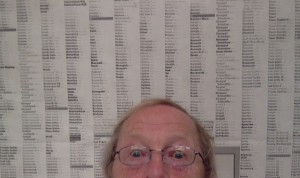The Knowledge of All Fonts
Thursday, July 9th, 2015It was Lorraine Shanley of Market Partners International who dubbed me ‘The Knowledge of All Fonts’, an epithet I eagerly seized upon. This is how it came about.
Jane Lloyd Ellis is a smart and beautiful woman. I’m also proud to call her my friend. I met her on a dive boat in the Red Sea in October 2001, and discovered we were neighbours in North London. (Actually her husband David looked over my shoulder as I was entering dive data into my Palm Pilot and commented “That’s the sort of thing that somebody living in London N4 would do, buddy.” I did, and so did they).
Jane worked in publishing, and I went to one of her launch parties. She stood up to introduce the authors, and I was bowled over by her easy, confident, witty manner, speaking without notes, including everyone, covering every angle, smart and sassy. Very impressive indeed.
Jane found out I had written a title for Pomegranate in San Francisco, ‘Fabulous Fonts’. So when her publisher Cassell Illustrated decided it was time for a twenty-first century update to their classic ‘Encyclopaedia of Typefaces’, she suggested me. Thus I was commissioned to write ‘The Encyclopaedia of Fonts.’
A little nomenclature: what we call Typefaces, Americans have always called Fonts. To us, a font (or fount, pronounced the same way) was the manifestation in a wooden tray of all the characters in one particular point size of a typeface.
I went to work. The first thing I did was to define typefaces as hot metal, fonts as digital. Then I upended 3,000 fonts onto the floor and set about sorting them out stylistically and chronologically by date of design, so you could see at a glance the type styles that influenced the creation of Times New Roman, and if you wanted to use something similar to TNR but more modern, then there it was right in front of you. It was a nightmare task, and nearly cured me of my love for fonts for good. You cannot believe how hard it was in those days even to find out the name of the designer of most fonts; the foundry always took the credit. Corporate appropriation, even in the nineteenth century.
But then Jane left Cassell, and so did my editor, and other people I knew at the firm, and new faces arrived, and there was no one left to stand up for me in house. The new managing director was an old adversary of mine. It was not good news for the book.
I delivered the manuscript on time. Eighteen months later the MD decided to release the title into the community on December 9th, at the peak of the Christmas bookselling rush. There was no publicity. As a result copies went into bookshops, sat in a corridor at the back of the shop, then got returned in the same unopened box in January.
No reviews, no royalties. An orphan book. I’ve heard nothing from the publishers since.
Then one evening I was watching University Challenge, and Jeremy Paxman asked a starter for ten: “In a book on the subject by Gwyn Headley, what are described as ‘the clothes words wear‘?”
Answer: Fonts, of course. They didn’t get it. And I blushed scarlet, scarlet, scarlet, just sitting with Von, the two of us in front of the telly in Harlech. How odd, random and unfair embarrassment is. That’s why I can’t ask a question in public. And why I admire people who can speak easily and fluently.
I’ve been asked a number of font-related questions recently, and I got to wondering about the book.
This morning I discovered it had been reviewed! By someone called Frances Follon, in The Art Book, Volume 13, Issue 4, page 69, November 2006. There had been one other review, in the Dorset Evening Echo, and it reproduced the first paragraph of the jacket blurb verbatim. Be grateful for small mercies, Gwyn.
The trouble is that if I want to read what Ms Follon has to say about my book — good or bad — I have to pay for a copy of her article. And the fee is $38. That’s more than I made in royalties from the sale of the book.
So I’m stuck. Unless Ms Fallon reads this and takes pity on me.
The dive data from the Palm Pilot? Long lost in some digital heaven.


